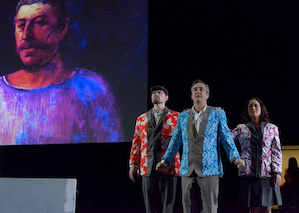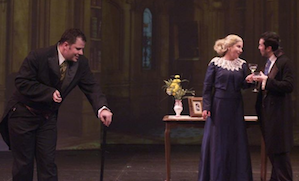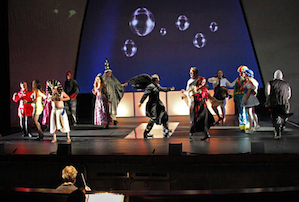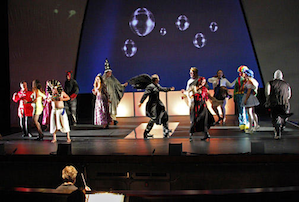
On a recent Sunday in April, conductor Mary Chun lowered her baton after the final sparkling note of Bonjour M. Gauguin, a contemporary chamber opera. Loud applause followed as the small cast of singers, dancers, and Chun took their bows. San Francisco-based Chun wasn't in Hamburg or Montreal, some of her usual conducting haunts. Her enthusiastic and sophisticated matinée audience, rather, was seated inside a suburban public high school theater for the Berkeley-based West Edge Opera production.
The El Cerrito Performing Arts Theatre at El Cerrito High School, however, is something different than might be imagined. The 600-seat, $25 million venue, financed through municipal bond issues, is tricked-out with plush, ergonomically-designed chairs, an orchestra pit that lowers, and a fly system to move scenery.
The theater’s low rental fees helped the critically-acclaimed troupe regain its financial footing following a difficult 2012 season. Things continued looking up, fiscally, after its well-received version of Monteverdi's L’incoronazione di Poppea this February. “We thought we were doing well,” says the company's General and Artistic Director Mark Streshinsky. Then the City of El Cerrito raised the theater’s rental fees, causing the ensemble to rethink everything from programming to set expenses.
Welcome to the world of small opera companies, where rising costs and diminished private and public support require a constant shifting of gears to stay viable. Some companies are reinventing themselves with complex business models. Others are sharing productions as a way to trim costs and increase production values. No matter what model these companies choose, however, they’re all chasing funds to sustain themselves.
The Cost Squeeze
After West Edge Opera received the bill, its Board president insisted on finding the money to stay at the Theatre. The company, which sports an annual operating budget of $275,000, of which $141,000 is earmarked for production costs of three operas a year with orchestra, is mulling over ideas to find the needed funds.
“We zigzag from one financial crisis to the next, but we tend to go for it whether we have the money or not.” – Mark Streshinsky, Artistic Director, West Edge Opera
All the same, the increased theatre fee is forcing West Edge to rethink its venue and budget, which, in turn, may affect artistic decisions, ranging from casting and sets to the number of musicians who can be hired to programming decisions hinging on copyrighted opera licensing fees. The upshot is there may be a lot of creative triage to come, but in many ways it is par for the course for West Edge. “We zigzag from one financial crisis to the next,” says Streshinsky. “We need to grow financially and the goal is to get to a place where we're not struggling. But we tend to go for it whether we have the money or not.” Streshinsky, an optimist's optimist, thinks it will work out.
The small opera company is able to attract marquee singers, choreographers, and composers and offer high production values on essentially a shoestring. “It’s all about connections,” says Streshinsky, who is married to the American soprano Marie Plette, whom he met when both were training in the San Francisco Opera Merola Program (Plette as a singer, and Streshinsky as a technical apprentice). He grew up near El Cerrito in the leafy suburb of Kensington, where he now lives with Plette, and their school-age son.
On the table for West Edge is the big decision of whether to stay at the high school, Streshinsky’s alma mater, where he performed in student musicals, as well as with a local community theater before going on to study cello and theater at the University of California, Santa Cruz. But there are other challenges at play for the thirty-year-old company Streshinsky joined in 2009 as artistic director.
West Edge is one of over a dozen small professional opera companies that call the San Francisco Bay Area home. The companies stretch geographically from North Bay Opera in Petaluma to Opera San Jose and West Bay Opera in Palo Alto, to Livermore Valley Opera in the East and Pocket Opera in San Francisco. Each troupe has tried to carve out a niche for itself, some focusing on staging scaled-down audience favorites. Others present brave new works, or offer a combination of contemporary and traditional programs. Some were recently at the brink of insolvency but have bounced back in different ways — for now. But in an era of diminished resources and overlapping audiences and donors, can the Bay Area support so many small opera companies whose annual budgets are under $1 million?
The bottom line for all of them is: Opera is big, opera is expensive. While venue costs can swell the budget of West Edge, formerly known as Berkeley Opera, the need for an orchestra, even pared down to one that is chamber size, represents a large chunk of production costs. When a mid-size opera company like New York City Opera can crash, it's a clarion call for smaller companies to reassess themselves and adjust their mission statement on a regular basis, suggests Marc Scorca, who heads Opera America, a national service organization in New York City.
Opera’s Big Expansion
Small opera companies sprang up not only in the San Francisco Bay Area but around the United States in the 1960s and 1970s. In the Bay Area, the numbers grew and these companies morphed into a hyper-localism that led to sharing many of the same audiences and donors, says Scorca.

Some casual observers say it was the dot-com boom of the late 1990s that led to the proliferation of small opera companies around the Bay Area. But experts disagree. “I don't think it came from funding; I think it started from the artists,” says Sara Nealy, executive director of Festival Opera. The Walnut Creek-based company, now in its third decade, is the third largest opera producer in the San Francisco Bay Area and has done a number of locally celebrated productions with high-level professionals, under their charismatic Music Director, Michael Morgan.
“There are so many talented people,” adds West Edge Opera’s Streshinsky. “And they’re saying, ‘I’m a talented person. I'm not doing the kind of work I want to be doing for a company, so I'll start my own.’”
Opera America’s Scorca agrees. The number of opera training programs and conservatories graduating voice and opera students has increased since the 1990s, outnumbering the jobs available for opera singers, he says: “There are more aspiring artists than the established infrastructure can support. With entrepreneurial spirit, they’re creating opera ensembles of their own.” Entrepreneurial desire to have an opera company may not always reap financial and critical success, note observers. “Quality is a tricky word,” says Scorca. “If you define quality as about size, there is nothing like San Francisco Opera. If you define quality — and this is where the audience comes in — as about really unexpected pieces, then for some people West Edge or Opera Parallèle may provide surprise. For others, it’s about youthfulness. It’s very subjective and it’s up to the audience to decide what they want.”
Other factors fueled the growth of the Bay Area’s small opera companies, observes Scorca. He cites the area’s unique geography, which, divided by a major body of water, and bounded by hills, lends itself to arts organizations nesting themselves in the cities (such as Oakland and Berkeley) and in communities that developed around San Francisco, starting in the 1940s. In the past, many of these were bedroom communities, he notes. They were places where people slept and mowed their lawns. They worked, dined at fabled restaurants, shopped in toney stores, and attended cultural events, however, in San Francisco. Then the advent of what urbanists call “edge cities” took root, and residents not only lived in communities such as Walnut Creek or San Jose, but they could work there, dine at fine restaurants, shop, and attend professional-quality opera, theater, or other cultural offerings. “It’s possible now to have wonderful places close to where you live to see opera,” says Scorca.
Tightening the Belt, Preserving the Product
The economic crash of 2008 tightened resources even more for small opera companies around the country. To stay in the game, many small Bay Area opera companies are finding different ways to survive and thrive in the current fiscal climate. Some are reinventing themselves, some are sharing productions, and still others are using technology in new ways or seeking alternative, low-cost venues.
Festival Opera executive director Nealy had recently joined the 20-year-old company when she and her board grasped the magnitude of the challenges they faced in 2011. Nealy, a veteran arts administrator with a background in corporate branding and marketing, had led the Livermore Valley Opera for a short time before accepting the Festival Opera position.
After realizing the staggering debt the company was in — a $200,000 deficit on an annual budget of $750,000, according to The San Francisco Chronicle — they questioned whether to triage or give up, recalls Nealy in a telephone interview. “We had to ask ourselves, Why go on? I really had to decide if we had a vision and a direction to proceed in, and a reason to be, artistically.” She and company stakeholders chose to go through an assessment.
“We have to have money so that, once in a while, we can fail. Otherwise, we could do Carmen every year but we couldn't call ourselves an arts organization.” - Sara Nealy, Executive Director, Festival Opera
She turned to Opera America’s Scorca for consultation, as well as to heads of small opera companies around the country. Over the course of a year, Scorca helped her to map a new direction for the company that calls the Lesher Center for the Arts in Walnut Creek home. The end result was a new vision for Festival Opera’s future that could be a Harvard Business School case study. In a letter to patrons and friends on Festival Opera’s website, underneath a carefully chosen image of Paul Gauguin’s 1897 Tahitian painting — ‘Where Do We Come From? What Are We? Where Are We Going?’ — Nealy outlined Festival Opera's challenges and solutions.
Steps the company is taking to get back on track include producing one fully staged, standard repertory opera per season (down from two, previously). For 2013, they’re sharing a production of Giuseppe Verdi’s Otello with West Bay Opera (which opens this week in Palo Alto and plays at the Lesher Center June 28 and 30).

With a focus on giving back to its community, Festival Opera will stage its annual, free Opera-in-the-Park event, and it’s second yearly production will present contemporary chamber operas in venues removed from the Lesher Center. As Nealy and her board work to return the company to solvency, she is in the process of moving away from an expense-based budget to a revenue-based budget. Fund-raising for this company has been strong: “With the help of loyal and committed patrons, foundations, and benefactors, we’re halfway to our goal of a balanced budget,” Nealy said, although she declined to give a budget amount.
She is applying ideas that may be more at home in a business enterprise than a nonprofit arts organization. “Opera companies need to think a little more like corporations in terms of offering a product line,” she advises. “The product needs to be excellent. But what an opera company, or any arts organization, gives to a community transcends the revenue it brings. Truthfully, we’re not going to be profitable. We need to make enough to have a reserve fund, and we have to have money so that, once in a while, we can fail. Otherwise, we could do Carmen every year but we couldn't call ourselves an arts organization. Art has to be dynamic and growing. One of the most important thrusts is to find vehicles that bridge to new audiences.”
To find such audiences, Festival Opera is exploring new communities with strong links to the arts but not necessarily connected to opera. A big challenge is defining audiences. “It’s not an homogenous experience,” Nealy says. “Some people only want to see what has been done before. For others, that bores them to tears; they only want to see new things. So it’s finding the right balance of all of these. If a mix of these is not the new normal by 2014, then we'll explore where we’re not getting traction.”
Production-Sharing Pros and Cons

Sharing an opera’s production is one model of decreasing a small opera company’s expenses while increasing production values. West Edge Opera shared a production of Don Giovanni with Livermore Valley Opera a few years ago and it worked well, says Streshinsky. That said, he doubts future shared productions are in the cards for West Edge. “The issue is finding similar aesthetics, style, practices, and standards,” he explains. “It’s also hard to share ownership and creativity.”
Sharing a co-production of Otello is going smoothly for Nealy and West Bay Opera General Director José Luis Moscovich. “Sara and I work very well together,” says Moscovich. The two companies are sharing the cost of Otello’s director, as well as casts, sets, lighting design, costumes, and a two-minute video trailer for the opera. They each will present Otello at their respective theatres with their own chorus, orchestras, and conductor.
“[The musicians] understand that everyone needs to pitch in to keep the company solvent There’s a team spirit that can help us to redefine ourselves. There’s a sense of shared responsibility.” – Jose Luis Moscovich, General Director, West Bay Opera
“Not only do both companies save costs by sharing a production, but sharing benefits can materialize in different ways,” says Moscovich in a telephone interview in between rehearsals. “There’s a net reduction in costs, and by combining resources we both get a better set and better production values than if we’d each done it alone.”
While it operates in cash-flush Silicon Valley, West Bay Opera faces the same challenges as other small opera companies. “There’s absolutely no money for operating funds coming from foundations or government,” says Moscovich, who grew up in Argentina, where he studied clarinet and conducting before moving to the United States to pursue training as an engineer and transportation planner in addition to continuing his musical education. What’s more, he notes, funding organizations are focusing on new opera. “If we do that, we're forcing new repertoire down people’s throats,” he says. “Traditional audiences expect traditional repertoire. It’s the bread and butter for us.”
It is also West Bay Opera’s Catch-22. Its audience is older and they want traditional opera repertory. Traditional opera repertoire, however, calls for larger orchestras and more singers, leading to higher production costs. According to Moscovich, there is more grant money available for staging productions of new or contemporary operas. It’s a dilemma for the company. “In order to create a new work, I have to have a healthy financial picture,” he says. “Who is going to help me pay for traditional productions? Ticket sales only pay for half. Who is going to pay for the other half?”
The Volunteer Spirit
Moscovich, however, has created a slightly different model for West Bay, preserving its repertoire, but utlizing some solutions such as production sharing. Is a consolidation of the two companies in the cards? “I think it's a little too early to think of consolidation,” says Moscovich. “This is a developmental path from a pilot to one shared production. We’re open to another collaboration, in a year, maybe two.” Each company has strengths they’ve built on. A large team of committed volunteers form a large part of West Bay’s strengths. “It's something we bring to a production. Our per-hour labor costs, or per-hour items are lower than for some companies.”
West Bay is also incorporating more technology into its productions. The shared production of Otello will utilize video projections as part of its stage set. “It’s a more contemporary appeal,” says Moscovich. “It’s the format that changes, not the subject matter,” he adds. The result is much lower set costs, which makes it easier to share a production with other companies.
Musicians are always a large part of an opera company's budget. West Bay has a unionized orchestra. In an unusual approach to managing fiscal realities, Moscovich approached the musicians in the orchestra to explain the company’s economic challenges. The musicians responded by volunteering their services at a June 23 benefit gala. “They understand that everyone needs to pitch in to keep the company solvent,” he says. “It’s a wonderful thing. There’s a team spirit that can help us to redefine ourselves. There’s a sense of shared responsibility.”
How Many is Too Many?
But as these performing arts group struggle to reinvent themselves in a tough economic climate, some experts wonder whether it makes sense for the Bay Area to have so many small opera companies. “There’s no reason why smaller companies cannot just survive but thrive,” says Moscovich. “There’s enough of a demographic to sustain these companies.”
Adds West Edge Opera’s Streshinsky: “I think the audience is there, regardless of the economic downturn. I think they’re not going to see operas because they don’t know they're happening.”
How many such companies, however, are really viable and meant to be sustained in perpetuity as a cultural pillar of their communities? Are many of them phasing through an artistic life-cycle of their leadership’s creative fervor?
Scorca pauses momentarily. “If a particular community is served by an opera company, it doesn't make a whole lot of sense to start another opera company that does the same thing in the same community,” he says, noting that Washington D.C. hosts a cluster of small opera companies and they complement each other, “Artistic fervor is good. It allows people to define themselves in a niche. But when a community is as large as the San Francisco Bay Area, there are plenty of places that can be well served.”
The approach, he says, is to be thoughtful so that each company isn’t duplicating what the other is doing, and to identify a specific niche. “An organization is more likely to succeed,” he suggests, “when it has clarity of vision, dynamic leadership and public appeal than when an organization’s mission is foggy and leadership is weak.”
Nealy doesn’t believe that survival of small opera companies is Darwinian. As some companies fold, others will pop up, she says: “Funded or not, strategy or not, more new companies will bubble up. Everyone talks about sustainability, including me, but there is also such a thing as a lifecycle; an organization can choose to begin again, or cease to be, and that’s okay. If an art form doesn’t find its audience, then maybe it should go away.
“Festival Opera is in a sense at the end of a cycle,” she continues. “We can’t continue doing what we’ve done in the past in the same way. That’s no longer sustainable. We’re looking at ways to connect with the community, building new audiences, and exploring different scales of production using high artistic standards as the compass.”
“Mission Control, We Have Identified Purpose”
Whether small opera companies in the San Francisco Bay Area are meant to be sustained in perpetuity as a cultural pillar of their community is another question, says Scorca. “I believe San Francisco Opera does have the responsibility to steer that company into the future. I don’t know if longevity is the goal of some of these smaller companies. If three young artists get together for ten years, and the ensemble doesn’t make it, and they each go off to do other things, that’s what that ensemble was.”
West Edge Opera’s Streshinsky envisions his company’s longevity lasting beyond his tenure with it. “Many people say the feel of the company is me,” he says. “I don't agree — it’s what the board wants, moving forward. I’d like to think West Edge will continue to be a pillar for creative opera work.”
He hopes West Edge will continue risk-taking into the future. “The worst thing that could happen to us is not taking risks,” he says. “You can’t make good art without taking risks.”
But companies like Moscovich’s West Bay Opera trend toward risk aversion. The company’s primary focus is on taking care of the audience it already has. “If our audience cohort is 60 to 90 years old, then we're working to keep them,” says Moscovich. “People are living longer, and want a quality of life.” These patrons like doing things locally, notes Moscovich, formerly a noted transportation planner. “It reinforces the point that the audience for opera and classical music is an older audience, and transportation plays a role in the choices they make. Part of West Bay’s strategic plan is to have better parking options and a shuttle. “We're not leaving it up to the audience to figure out how to get to the theater.”
In a bid to attract significantly younger opera fans, West Bay Opera will hold a contest for Peninsula youth to design a two-minute promotional video for its 2014 production of The Magic Flute. The winner will get to design all three opera videos for the company's next season, which also includes Tosca, and L’elisir d’amore. “It's not just getting them to make the videos, it’s also getting engagement with kids and exposing them to opera,” says Moscovich.
“Maybe that’s the way we make change — one person at a time. It’s solid change, but not fast change.”

